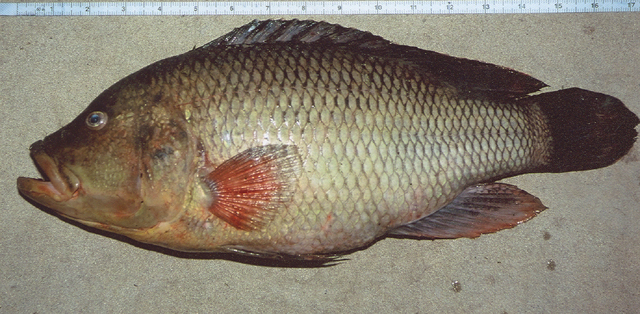| Cichlidae (Cichlids), subfamily: Pseudocrenilabrinae |
| 56 cm TL (male/unsexed); max.weight: 6,123.0 g |
|
demersal; freshwater; depth range - 2 m |
| Africa: Lake Malawi, rivers flowing into it, and the outflowing Shire River and Lake Malombe (Ref. 39192, 52193, 55954, 79521, 97235, 128638). It was introduced from Lake Malawi into the upper Ruo River in Malawi (Ref. 7248), and Sand River Dam in Swaziland (Ref. 7248, 128638), where it established and spread into the Komati River system in South Africa (Ref. 128638); verbal reports from Mozambique indicate the species has recently spread onto the Mozambique coastal plain (Ref. 128638). Serranochromis species in the Luangwa River may be S. robustus based on photographs taken by anglers, but specimens ar nedded to confirm this (Ref. 128638). |
|
Dorsal spines (total): 15-16; Dorsal soft rays (total): 13-16; Anal spines: 3-3; Anal soft rays: 10-11. Diagnosis: The presence of four or five scale rows between the posterior margin of the orbit and the ascending arm of the preoperculum, the presence of widely set unicuspid teeth on the jaws, widely separated gill rakers, and anal fins with egg ocelli places this species in Serranochromis (Ref. 128638). Breeding males of S. robustus possess ocelli that are restricted to the posterior 4-5 membranes of the anal fin, which delimits them from all other Serranochromis species, which have ocelli throughout the anal fin in breeding males, with the exception of S. jallae (Ref. 128638). Serranochromis robustus generally has a longer lower jaw than S. jallae, 50.7-59.6% of head length vs. 49.2-52.7%; it is not as deep-bodied as S. jallae as evidenced by the distance between the posterior insertion of the dorsal fin and the posterior insertion of the anal fin, 13.4-15.1% of standard length in S. robustus vs. 14.9-18.4% in S. jallae; additionally, S. robustus has a narrower least caudal peduncle depth than S. jallae, 10.9-12.8% of standard length vs. 11.3-14.2%, the least caudal peduncle depth of all S. robustus was less than 12.8% of standard length while for S. jallae, except for the smallest specimen, the least caudal peduncle depth was greater than 13.2%; Serranochromis robustus has a smaller horizontal eye diameter than S. jallae, 17.7-27.4% of head length vs. 18.6-25.5%; in general, S. robustus has more teeth in the outer row of the left lower jaw than S. jallae, 14-23 vs. 13-14 (Ref. 128638). Adults in breeding colour of Serranochromis robustus are blue/green laterally with a narrow yellow marginal band on the dorsal fin and usually a small yellowish tip to the upper caudal-fin lobe; adults in breeding colour of S. jallae are yellow/green laterally with a bright orange marginal band on the dorsal and caudal fins in fish from the Okavango River system, but creamy yellow bands in fish from the upper Zambezi River system; the throat and belly of S. jallae becomes more intensely yellow-orange in breeding dress hence the local name 'yellow-belly'; rarely, specimens from the Okavango River in Namibia also have yellow rather than orange marginal bands (Ref. 128638). Description: Head elongate, 36.2-38.0% of standard length; cheek depth 26.1-33.5% of head length; snout elongate, 35.2-39.8% of head length, and posterior end of lower jaw anterior to anterior margin of orbit (Ref. 128638). Two pored scales posterior to hypural plate, and 9-11 rows of scales on cheek; one or two scales between pectoral fin and posterior margin of opercle; lateral line scales 37-39 (Ref. 128638). Outer arch of epibranchial with 4-5 gill rakers; outer arch of ceratobranchial with 10-12 gill rakers (Ref. 128638). Teeth in 2 series on upper and lower jaws (Ref. 128638). Caudal fin emarginate and lacking marginal band in breeding adult males; pectoral fin directly under origin of dorsal fin; pelvic fin posterior to origin of dorsal fin; dorsal fin with 15-16 spines and 13-16 rays, anal fin with 3 spines and 10-11 rays, pelvic fin with 5 rays, pectoral fin with 13-16 rays (Ref. 128638). |
| It occupies mostly complex habitats in water shallower than 10 m; mostly found near river outlets and in the southern part of Lake Malawi; in southern Lake Malawi it is generally associated with the rock/sand interface or, associated with submerged aquatic vegetation and among reed beds in shallow water and inlets (Ref. 5595, 128638). Present in calm coves or slow flowing sections of rivers with vegetation; not common in Lake Malawi, but abundant in larger rivers (Ref. 4967). Piscivore, hunting mbuna and sand-dwelling haplochromines; mouthbrooder (Ref. 5595). Oviparous (Ref. 205). Breeds in summer (Ref. 7248). |
|
Critically Endangered (CR); Date assessed: 20 June 2018 (A2c+3cde) Ref. (130435)
|
| harmless |
Source and more info: www.fishbase.org. For personal, classroom, and other internal use only. Not for publication.

